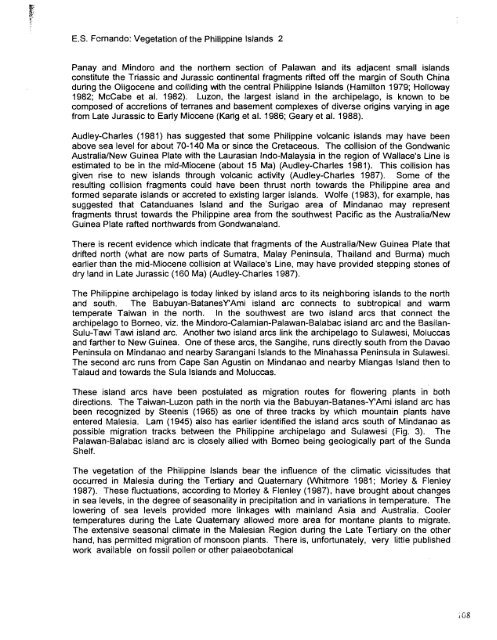United States Agency for International Development - (PDF, 101 mb ...
United States Agency for International Development - (PDF, 101 mb ...
United States Agency for International Development - (PDF, 101 mb ...
You also want an ePaper? Increase the reach of your titles
YUMPU automatically turns print PDFs into web optimized ePapers that Google loves.
E.S. Fcmando: Vegetation of the Philippine lslands 2<br />
Panay and Mindoro and the northern section of Palawan and its adjacent small islands<br />
constitute the Triassic and Jurassic continental fragments rifted off the margin of South China<br />
during the Oligocene and colliding with the central Philippine lslands (Hamilton 1979; Holloway<br />
1982; McCabe et al. 1982). Luzon, the largest island in the archipelago, is known to be<br />
composed of accretions of terranes and basement complexes of diverse origins varying in age<br />
from Late Jurassic to Early Miocene (Karig et al. 1986; Geary et al. 1988).<br />
Audley-Charles (1981) has suggested that some Philippine volcanic islands may have been<br />
above sea level <strong>for</strong> about 70-140 Ma or since the Cretaceous. The collision of the Gondwanic<br />
AustraliaINew Guinea Plate with the Laurasian Indo-Malaysia in the region of Wallace's Line is<br />
estimated to be in the mid-Miocene (about 15 Ma) (Audley-Charles 1981). This collision has<br />
given rise to new islands through volcanic activity (Audley-Charles 1987). Some of the<br />
resulting collision fragments could have been thrust north towards the Philippine area and<br />
<strong>for</strong>med separate islands or accreted to existing larger islands. Wolfe (1983), <strong>for</strong> example, has<br />
suggested that Catanduanes Island and the Surigao area of Mindanao may represent<br />
fragments thrust towards the Philippine area from the southwest Pacific as the AustraliaINew<br />
Guinea Plate rafted northwards from Gondwanaland.<br />
There is recent evidence which indicate that fragments of the AustraliaINew Guinea Plate that<br />
drifted north (what are now parts of Sumatra, Malay Peninsula, Thailand and Burma) much<br />
earlier than the mid-Miocene collision at Wallace's Line, may have provided stepping stones of<br />
dry land in Late Jurassic (1 60 Ma) (Audley-Charles 1987).<br />
The Philippine archipelago is today linked by island arcs to its neighboring islands to the north<br />
and south. The Babuyan-BatanesYAmi island arc connects to subtropical and warm<br />
temperate Taiwan in the north. In the southwest are two island arcs that connect the<br />
archipelago to Borneo, viz. the Mindoro-Calamian-Palawan-Balabac island arc and the Basilan-<br />
Sulu-Tawi Tawi island arc. Another two island arcs link the archipelago to Sulawesi, Moluccas<br />
and farther to New Guinea. One of these arcs, the Sangihe, runs directly south from the Davao<br />
Peninsula on Mindanao and nearby Sarangani lslands to the Minahassa Peninsula in Sulawesi.<br />
The second arc runs from Cape San Agustin on Mindanao and nearby Miangas Island then to<br />
Talaud and towards the Sula lslands and Moluccas.<br />
These island arcs have been postulated as migration routes <strong>for</strong> flowering plants in both<br />
directions. The Taiwan-Luzon path in the north via the Babuyan-Batanes-YAmi island arc has<br />
been recognized by Steenis (1965) as one of three tracks by which mountain plants have<br />
entered Malesia. Lam (1945) also has earlier identified the island arcs south of Mindanao as<br />
possible migration tracks between the Philippine archipelago and Sulawesi (Fig. 3). The<br />
Palawan-Balabac island arc is closely allied with Borneo being geologically part of the Sunda<br />
Shelf.<br />
The vegetation of the Philippine lslands bear the influence of the climatic vicissitudes that<br />
occurred in Malesia during the Tertiary and Quaternary (Whitmore 1981; Morley & Flenley<br />
1987). These fluctuations, according to Morley & Flenley (1 987), have brought about changes<br />
in sea levels, in the degree of seasonality in precipitation and in variations in temperature. The<br />
lowering of sea levels provided more linkages with mainland Asia and Australia. Cooler<br />
temperatures during the Late Quaternary allowed more area <strong>for</strong> montane plants to migrate.<br />
The extensive seasonal climate in the Malesian Region during the Late Tertiary on the other<br />
hand, has permitted migration of monsoon plants. There is, un<strong>for</strong>tunately, very little published<br />
work available on fossil pollen or other palaeobotanical

















